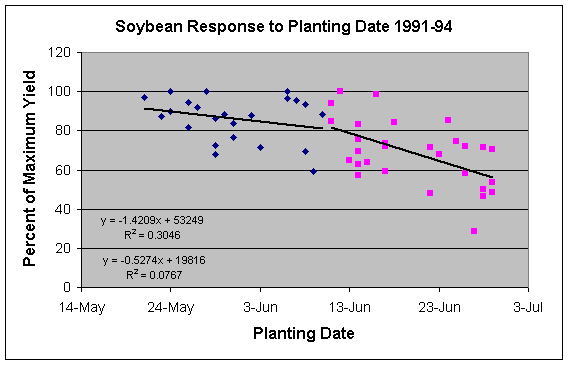Published 18 June 2008
URL: http://www.kingcorn.org/news/articles.08/LatePlantedSoy-0618.html
Heavy Rains and Flooding Equal Delayed Soybean Planting
Ellsworth Christmas
Agronomy Dept., Purdue Univ.
West Lafayette, IN 47907-2054
Email address: echristmas
at purdue.edu
Excessive rains and flooding equate to delayed soybean planting.
Northern Indiana producers should now change to an earlier maturity group of soybean.
![]() he
Indiana Crop & Weather Report for the week ending June 15, 2008 (USDA-NASS,
2008) indicated that about 20% of the acreage intended for soybean has yet
to be planted, with the majority of this acreage in the southern third of
the state. Rainfall reported across Indiana these past two weeks has been
very intense across central and southern Indiana. In general, total rainfall
across this part of Indiana is running as much as 10 to more that 15 inches
above normal for the year to date, with extensive flooding. Soybean planting
obviously has been delayed, with only 60% of the acreage reported as being
planted in southern Indiana as of June 15.
he
Indiana Crop & Weather Report for the week ending June 15, 2008 (USDA-NASS,
2008) indicated that about 20% of the acreage intended for soybean has yet
to be planted, with the majority of this acreage in the southern third of
the state. Rainfall reported across Indiana these past two weeks has been
very intense across central and southern Indiana. In general, total rainfall
across this part of Indiana is running as much as 10 to more that 15 inches
above normal for the year to date, with extensive flooding. Soybean planting
obviously has been delayed, with only 60% of the acreage reported as being
planted in southern Indiana as of June 15.
Delayed planting has less effect on the yield of soybean than on corn. Unlike corn, which requires a certain number of growing degree days to mature, the soybean is more sensitive to day length. As the day length shortens later in the growing season, soybean maturity speeds up. As a general rule of thumb, for each three days planting is delayed, harvest is delayed only one day. The soybean plant shortens each part of the reproductive phase of growth, resulting in a shorter plant with fewer pods. Below is a comparison of estimated yield reductions experienced by corn and soybean as planting is delayed.
| May 21 | May 26 | May 31 | June 5 | June 10 | June 30 | |
| Corn* | 9% | 13% | 19% | 25% | 32% | 50% |
| Soybeans | 0 | 2% | 4% | 7% | 10% | 38% |
| * Corn yield losses adapted from Nafziger (1994), Univ. of Illinois | ||||||
As yield levels of soybeans have increased over the past ten years or so, the percentage yield loss has increased slightly. For example, data from a recent study, given in the graph below, indicates that the reductions in yield for May 20 and June 10 average about 0.5%per day. Yield losses for the period from June 11 to June 30 average about 1.4 percent per day for each day of delay after June 10.

We are approaching the date where soybean planting has been delayed long enough to consider changing maturity groups. It is advisable to stay with a full-season variety of soybeans for your particular area until about June 15 in the northern quarter of Indiana, June 20 for the central half of Indiana and June 25 in southern Indiana quarter of the state. Full season soybeans will almost always yield better than shorter season varieties for a given geographic area even when planting is modestly delayed.
Once June 15 has been reached in northern Indiana, June 20 in central Indiana, and June 25 in southern Indiana, producers should move from a full season variety of soybeans to a mid season variety for their respective area. This will equate to a change of one-half maturity group assuming that a full season variety is being grown. Additionally, seeding rates should be increased by 15 to 20 percent to promote shading and taller plants to increase podding height and to increase the number of nodes per acre. The increase in the number of pods per acre will help offset the reduced plant height and pod numbers caused by delayed planting.
A commonly used rule of thumb for a cutoff date to stop planting soybeans is 90 days prior to the first 32 degree frost for a given area within the state. Using a 25% probability, or one in four years of a 32 degree or lower temperature, the magical date for the Bluffton area in northeastern Indiana is June 30, while in the Lafayette area it is July 5. Soybean planting should cease in most of the southern half of Indiana by July 10 except for the southwest corner where planting can occur up to July 15.
Related References
USDA-NASS. 2008. Indiana Crop & Weather Report. USDA, National Ag Statistics Service. [On-line]. Available at http://www.nass.usda.gov/Statistics_by_State/Indiana/Publications/Crop_Progress_&_Condition/2008/wc061608.pdf. [URL accessed 6/18/08].

